They’d be accordions.
Drew Daly, COMPRESSION, 2006
One bureau, adhesive, lacquer
34 x 36 x 20.5 inches
Photo credit: Eric Eley
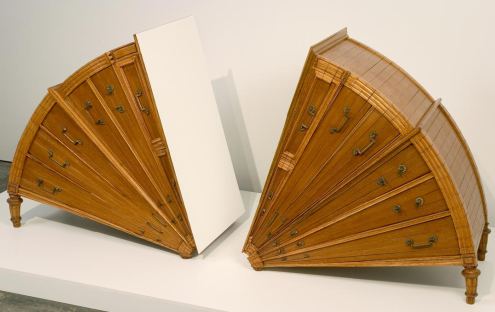 Peter Millett LEVERAGE, 2010
Peter Millett LEVERAGE, 2010
Welded steel
70 x 120 x 24 inches
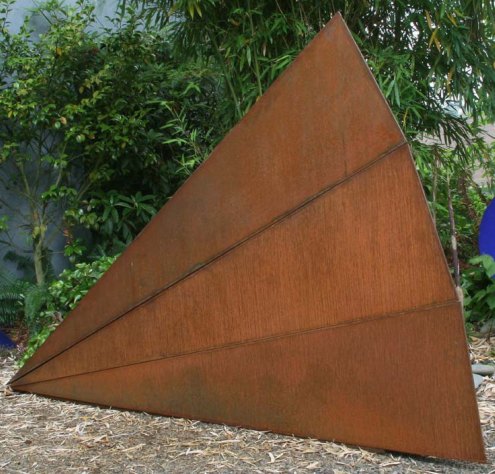
Regina Hackett takes her Art to Go
They’d be accordions.
Drew Daly, COMPRESSION, 2006
One bureau, adhesive, lacquer
34 x 36 x 20.5 inches
Photo credit: Eric Eley
 Peter Millett LEVERAGE, 2010
Peter Millett LEVERAGE, 2010
Welded steel
70 x 120 x 24 inches

Can measure his life.
John Kirchner My Sad Daily Life as Measured in
the Daily Paper, Newspaper, rain coat and steel
1994-2005
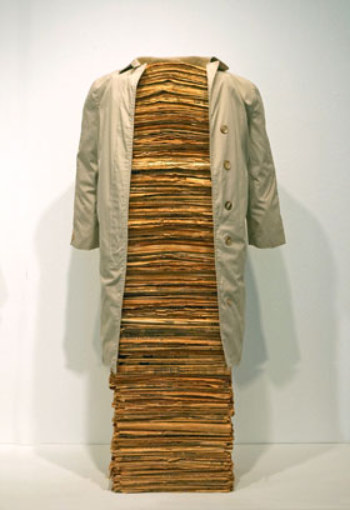
From muscle tissue with bacon scarf to smoke…
Derrick Jefferies
Anatomy (Muscle)
Polyethylene and tube lamps
2010
Backlight inkjet print & lightbox
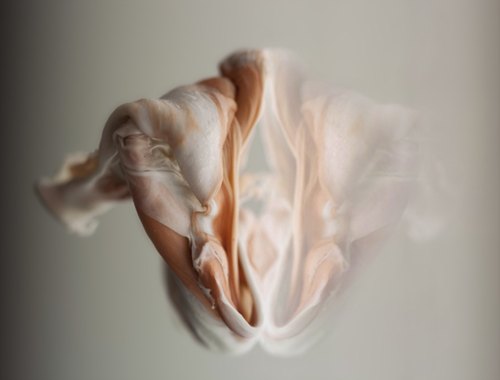
When I asked an addict what she got out of heroin, she said, “a shot of sainthood.” I thought of her when looking at Isaac Layman’s photographs at Lawrimore Project, the addict who has my face and sounds like I do on phone, sober now a long time and younger than I am but wrecked, always more wrecked.
Inside a drugged stupor, grace can deliver a hallucinated clarity. It’s only the world in Isaac Layman’s large prints, common as dirt, but his delivery has the force of revelation. Were you Saul, these photos would knock you off your horse.
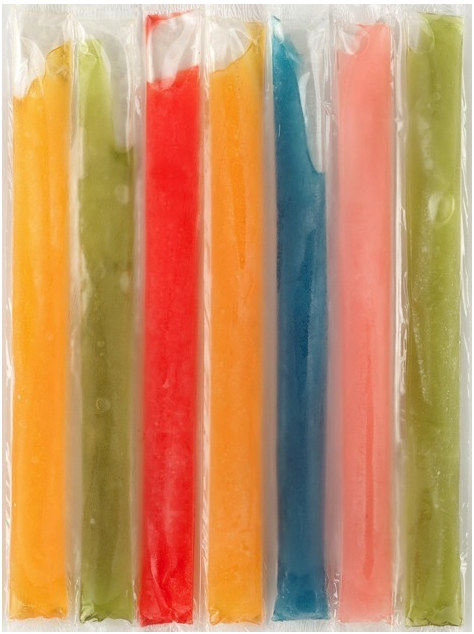 Because everything he shoots is too real to be real, the exhibit’s title is, 110 Percent.
Because everything he shoots is too real to be real, the exhibit’s title is, 110 Percent.
From Flannery O’Conner’s A Good Man Is Hard To Find:
His voice seemed about to crack and the grandmother’s head cleared for an instant. She saw the man’s face twisted close to her own as if he were going to cry and she murmured, “Why you’re one of my babies. You’re one of my own children !” She reached out and touched him on the shoulder. The Misfit sprang back as if a snake had bitten him and shot her three times through the chest. Then he put his gun down on the ground and took off his glasses and began to clean them.
Hiram and Bobby Lee returned from the woods and stood over the ditch, looking down at the grandmother who half sat and half lay in a puddle of blood with her legs crossed under her like a child’s and her face smiling up at the cloudless sky.
Without his glasses, The Misfit’s eyes were red-rimmed and pale and defenseless-looking. “Take her off and thow her where you thown the others,” he said, picking up the cat that was rubbing itself against his leg.
“She was a talker, wasn’t she?” Bobby Lee said, sliding down the ditch with a yodel.
“She would of been a good woman,” The Misfit said, “if it had been somebody there to shoot her every minute of her life.”
The moment that the grandmother is a good woman is the moment when the drug settles into the bloodstream and clears the mind, the moment when God speaks in the wilderness: the moment of transfixed understanding.
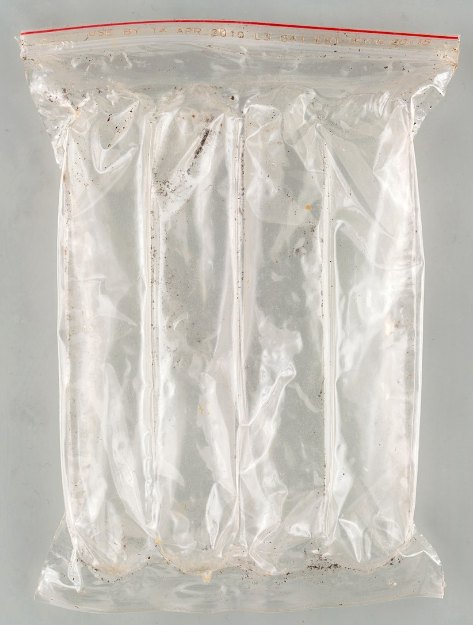 Working digitally, Layman combines layers of long exposures to get the same image stuck in a crater of a deepening visual repetition. It’s something like the idea of a rose is a rose, only simultaneously, as if everyone in a crowded room suddenly said “rose.” Everybody would say it a little differently.
Working digitally, Layman combines layers of long exposures to get the same image stuck in a crater of a deepening visual repetition. It’s something like the idea of a rose is a rose, only simultaneously, as if everyone in a crowded room suddenly said “rose.” Everybody would say it a little differently.
Below, Layman’s kitchen cabinet. He doesn’t own that many glasses.The photo is a long scan of the image, many exposures digitally stitched
together, like a quilt.
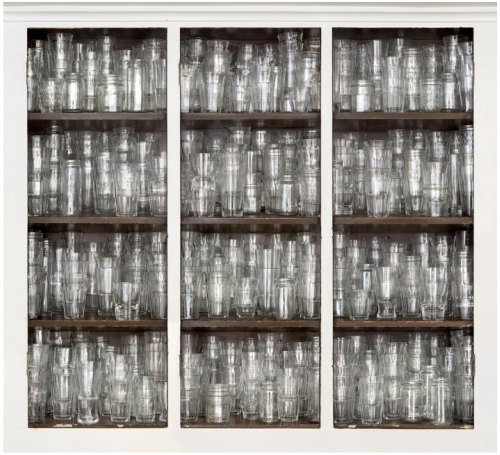 Max Beckmann said he didn’t need to abstract things, because “each object is unreal
Max Beckmann said he didn’t need to abstract things, because “each object is unreal
enough already.” Or, for Layman, too real.
More praise for Lawrimore Project: Curator Dan Cameron was in town for a lecture recently and took a day to look around with artists Gretchen Bennett and Joey Veltkamp.
Cameron’s Seattle report here. Below, what he had to say about LP:
Owned by Scott Lawrimore, a former Kucera protégé, the gallery is probably the most visually stunning commercial art space in the US, outstripping any comparable venue in either Chelsea or Culver City. The space is huge, and, more importantly, has been broken up by the Seattle firm Lead Pencil Studios into a cluster of rooms, each of which has an extremely precise character. Tall ceilings and indirect natural light are balanced by a renovation that leaves just enough of the original building’s quirks intact so that walking into Lawrimore feels like stepping into every artist’s ideal vision of an art gallery.
Lawrimore opened just in time for the recession. It’s still here, but this year is his financial best. He’s in the biz for the long haul, although his “visually stunning” venue is not. His lease is up next Halloween, his wife’s birthday. Anyone who bets on him signing another in that space will lose money. Layman closes on Aug. 14. Lawrimore has yet to schedule a show to follow it. If you want to see the place that beats the competition in Chelsea or Culver City, go now.
When in Tacoma, the last place on my list is the Museum of Glass. Its exhibits tend toward the didactic and its galleries have no natural light source, remarkable for a glass museum. With their low ceilings, they look like storage units.
Even so, I intended to see Preston Singletary: Echoes, Fire, and Shadows long before now. (It closes Sept. 19.) It’s hard to admit I was hesitant to see what MOG would do with this artist, but there it is. Fortunately, I was wrong. Not once inside this mid-career survey did I think about the limitations of the galleries. Credit goes to curator Melissa G. Post and the museum’s design crew. The show looks terrific.
(All images reproduce sculpture by Singletary, taken from his website. Part of this post comes from a 2002 profile published in the PI. )
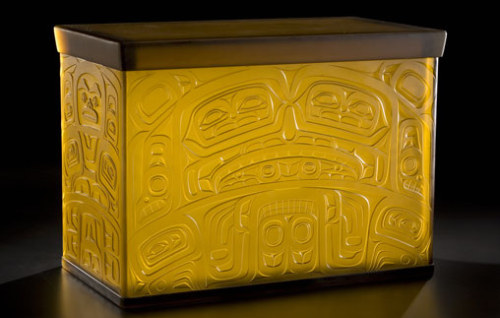 Singletary belongs to two tribes — the Tlingit nation into which he was born on his mother’s side, and glass, because glass at its core is tribal. In high school Singletary met lifelong friend Dante Marioni, whose father Paul took the boys to the counter-culture experiment in the woods that became Pilchuck Glass School. First generation artists in the studio glass movement were
Singletary belongs to two tribes — the Tlingit nation into which he was born on his mother’s side, and glass, because glass at its core is tribal. In high school Singletary met lifelong friend Dante Marioni, whose father Paul took the boys to the counter-culture experiment in the woods that became Pilchuck Glass School. First generation artists in the studio glass movement were
frequently at the house, and Singletary met them all.
After high school, glass offered an escape from college. Marioni managed to get his friend a job as night watchman at the Glass Eye. Thanks to his previous Pilchuck experience, he quickly moved onto the floor, blowing Christmas ornaments and other less seasonal decorations.
Glass was beginning to take off, and Singletary found himself along for
the ride.
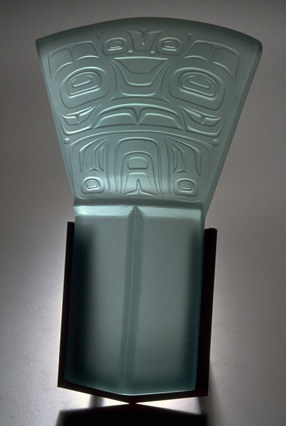 What he liked best was the company. No other form of contemporary art is such a clan venture. With music
What he liked best was the company. No other form of contemporary art is such a clan venture. With music
blaring and heat pouring out of the furnaces, glass artists root for
each other, criticize, applaud and collaborate.
In 1984, after two years of glass factory work, Singletary became Ben Moore‘s gaffer. Moore’s studio offered not only a paycheck but the chance to blow with some of the best glass artists in
the world.
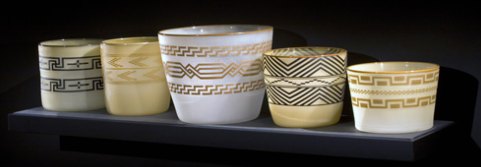 At Pilchuck, Singletary met Tony Jojola, who encouraged him to find a
At Pilchuck, Singletary met Tony Jojola, who encouraged him to find a
way to express his tribal heritage in the context of
contemporary glass.
In Alaska, he met David Svenson, a non-Native artist who opened up elements of Tlingit style Singletary hadn’t previously considered. Back in Seattle, Singletary thought the
hot glass bubble hanging precariously in front of him looked like a
Tlingit rain hat woven in cedar bark.
Eventually, he turned that shape upside down, transforming it into a
vase that all by itself would strike a familiar chord in Tlingit
circles.
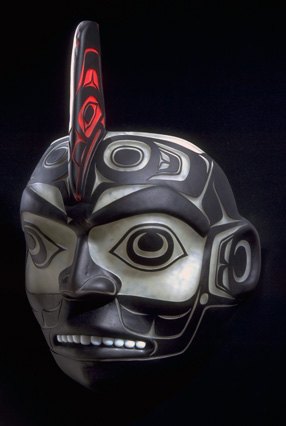 Using a sandblasting and
Using a sandblasting and
stenciling technique he developed himself, he carved Tlingit designs on
the outer surface.
As Ramona Gault observed in a 1998 cover article in the magazine,
“Indian Artist,” the result is a “conical shape that opens upward like a
lily, its undersurface carved with an animal image that is split like a
Rorschach inkblot. When a light source is positioned above the vessel,
the carved image is cast in shadow on the surface where the vessel
sits.”
Beneath the stark, crisp clarity of his line, blunt old harmonies assert themselves. He
uses glass to express his Tlingit heritage, merging the ancient art of
glass blowing with even more ancient artistic practices of his people in
order to create a 21st-century version of tribal aesthetics.
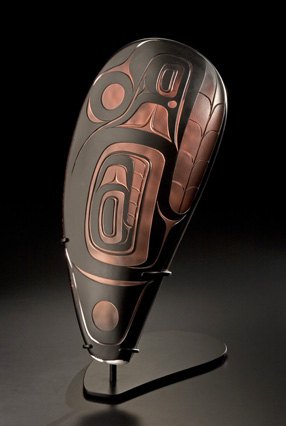 He’s grateful for the Indian artists working in glass who came
He’s grateful for the Indian artists working in glass who came
before him, including Larry Ahvakana, Joe David, John Hagen, the late
Conrad House, Marvin Oliver and Susan A. Point, as well as his
contemporaries, such as Ed Archie Noisecat, who carved the masks
Singletary has used as molds.
Thirteen years before 1963, when Singletary was born, Robert Bruce Inverarity wrote that the art of the Northwest
Coast Native Americans was “flourishing when Captain Cook, on his last
voyage, reached the coast in 1778; it had passed its peak by 1910 and is
almost dead today.” Were he still alive, Inverarity would be happy to have been proved wrong. The glass end of the Northwest Coast tradition that began in Seattle has inspired Native artists around the world, and Singletary is among its leaders.
For those who need another reason to visit the Museum of Glass, Martin Blank‘s installation in the courtyard plays like frozen music.
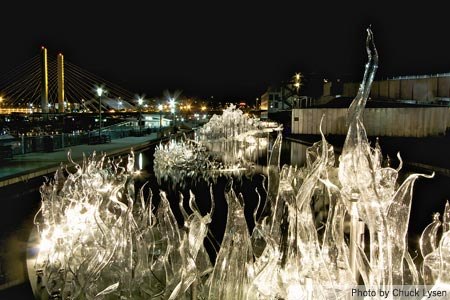
There’s a one-word hint in Michiko Kakutani opening paragraph that her review of Laurence Gonzales’ novel will take a disparaging tone:
Think of a contemporary version of Mary Shelley’s “Frankenstein” in which an egotistical scientist’s creation is not a hideous-looking monster but a well-mannered teenage girl who quotes Shakespeare, listens to Tom Petty and uses Facebook and YouTube. This is the high-concept premise of Laurence Gonzales’s lumpy new novel, “Lucy.” (more)
Right. It’s “lumpy.” When lumpy is the first descriptive in a book review, that review will fall short of rave. The same can’t be said in visual art, where a critic might easily use the word as praise. In visual art, silky is not a top and lumpy a bottom. They are just another spectrum across which artists secure a place.
(Via)
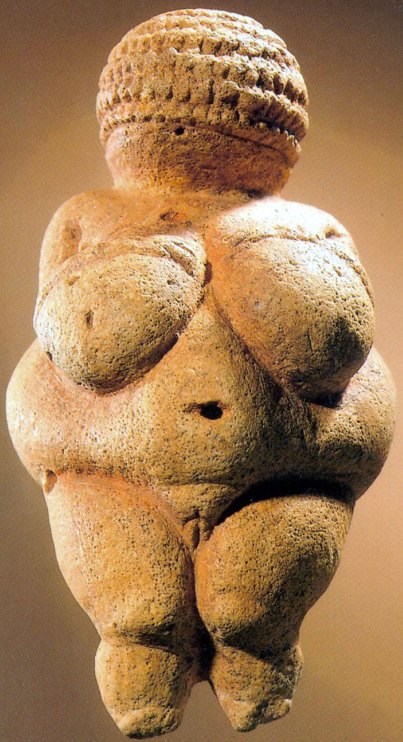
Click here, via Molly Norris.
From a physical understanding of volume, Peter Millett built a cake.
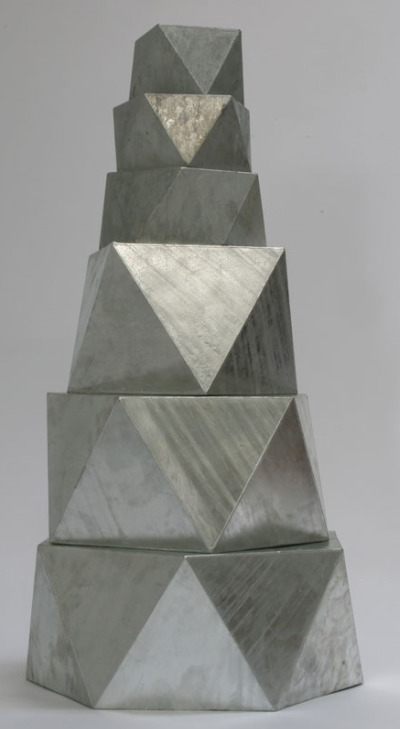 His triangles join, like cupped hands, to make a bowl.
His triangles join, like cupped hands, to make a bowl.
FEAST BOWL, 2009
Painted wood
25 x 21 x 8 inches
$7,500
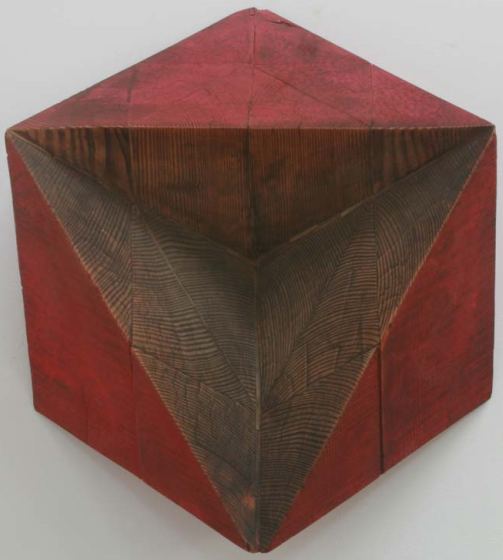 He moves back and forth between wood and steel, from carving into a solid to manipulating the empty skin of metal. In metal he can extend and twist a triangle. When triangles try to become a square, they fail, just as, in Millett’s mind, the American effort to remake Iraq in its image will fail.
He moves back and forth between wood and steel, from carving into a solid to manipulating the empty skin of metal. In metal he can extend and twist a triangle. When triangles try to become a square, they fail, just as, in Millett’s mind, the American effort to remake Iraq in its image will fail.
OPEN SQUARE, 2009
Welded steel
38 x 40 x 6 inches
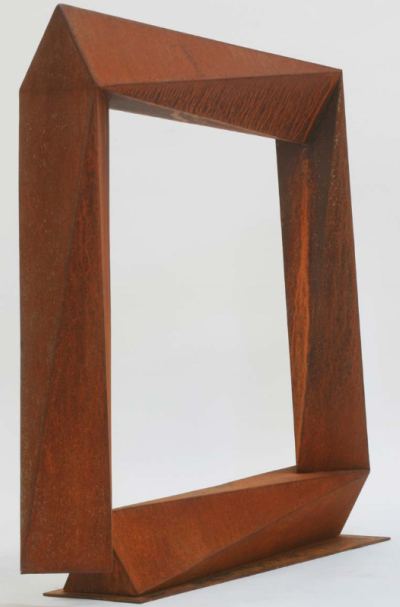 He makes no models or drawings for his sculpture, preferring to work directly with what he calls the “real stuff.” While real stuff is in his hands, real stuff is in his head. His current exhibit at Greg Kucera Gallery, titled Skyscrapers, is a tribute to architects who blur the line between sculpture and buildings, making art that people inhabit high in the sky. With a tough elegance that compromises on nothing, his sculptures and
He makes no models or drawings for his sculpture, preferring to work directly with what he calls the “real stuff.” While real stuff is in his hands, real stuff is in his head. His current exhibit at Greg Kucera Gallery, titled Skyscrapers, is a tribute to architects who blur the line between sculpture and buildings, making art that people inhabit high in the sky. With a tough elegance that compromises on nothing, his sculptures and
drawings collaborate to create a weathered sense of place.
Lisa Corrin called his
work “disembodied architecture,” and that’s certainly part of it.
In HOTSEAT (2010
Welded steel
60 x 22 x 12 inches), his imaginary architecture becomes an emblem of mourning. The moire-pattern of its skin function as windows, something like the Bridge of Sighs but more what prisoners in their Guantánamo Bay holding cells might see through chain-link. The few accused with evidence of substantial crimes mingle with those who were in the wrong place at the wrong time and those who are guilty of thought crimes.
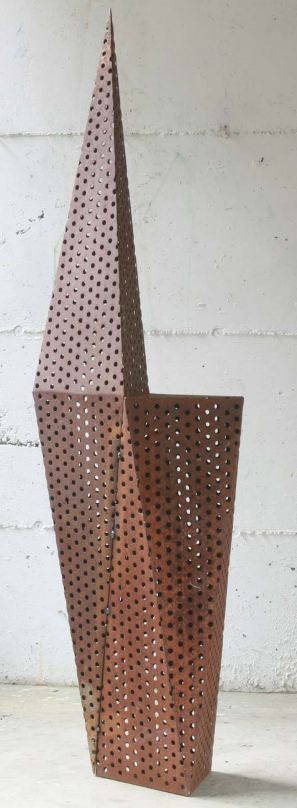 Decades ago, traveling in Iran, Millett was struck with the spare
Decades ago, traveling in Iran, Millett was struck with the spareThat admiration is the subtext of his modernist
form. Following Brancusi and Noguchi, his work is more elemental than
minimalist, rooted not just in nature but in human
nature. Millett has his rich color sense largely in check, giving free rein
only to rust. The range of his rust tonalities is a marvel, from cold
and dark to dappled across a fluid expanse and warm in places as
oven-baked bread.
Through August 14.
The Northwest sound continues to evolve.
Following William Blake, M. Ward turned Buddy Holly’s song of innocence into one of experience. I love how Ward lags slightly behind the beat, taking the plunge but knowing it won’t go well. The lyrics make more sense Ward’s way: “When you say, I love you, I say, rave on.”
Correction: The narrative in this post contains a crucial error. While Molly Norris published her cartoon – Will the Real Likeness of the Prophet Mohammad Please Stand Up? – she did not launch the Draw Mohammad Day facebook thread.
After Comedy Central censored an episode of “South Park” that featured Muhammad in a bear suit, The Simpsons responded:
 Who were they afraid of? The usual thugs ready to kill anyone who doesn’t see the world their way. Seattle artist Molly Norris attempted to lighten the issue with humor. Can’t depict Mohammad? How about as a purse, a cherry or a spool of thread?
Who were they afraid of? The usual thugs ready to kill anyone who doesn’t see the world their way. Seattle artist Molly Norris attempted to lighten the issue with humor. Can’t depict Mohammad? How about as a purse, a cherry or a spool of thread?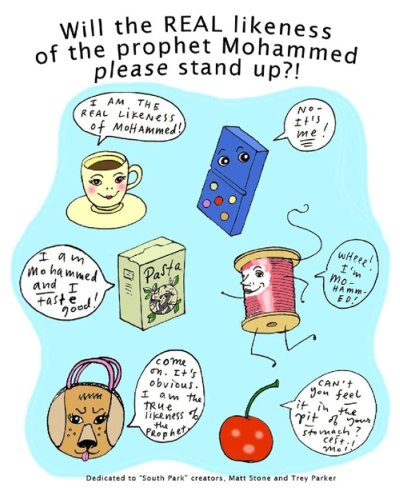
Thinking like would attract like, she opened a facebook page and invited everybody to participate in Draw Mohammad Day. She was right; like did call to like. There was humor, a significant amount of art savvy and a gentle protest against those who make death threats against cartoonists.
.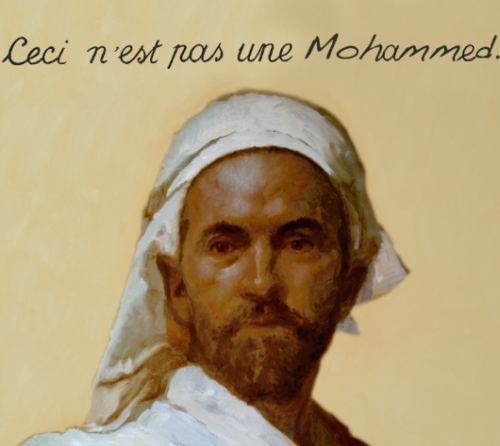 Then the haters showed up and filled pages with their contempt for all Muslims. Dismayed, Norris tried to shut it down. Too late, because hate also calls to hate.
Then the haters showed up and filled pages with their contempt for all Muslims. Dismayed, Norris tried to shut it down. Too late, because hate also calls to hate.
According to a Sunday story in the New York Daily News, Yemeni-American cleric Anwar al-Awlakih has singled her out for death, calling her a “prime target.” The FBI told her they are taking the threat very seriously.
If that isn’t bad enough, Huffington Post columnist Eric Lurio weighed in with his own attack on Norris, saying that her interest in gentle satire makes her a wimp and her interest in staying alive makes her a coward.
Dear Mr. Lurio: If you’re so interested in getting murdered, why don’t you go taunt a killer or two? How about thousands of killers? Want your name in their rifle sights? I don’t know if you’re a coward, but I do know you’re a bully, a bore and a fool. Crawl back under your rock and leave Molly Norris alone.
Below, Norris in 2008, on the right. On the left, her collage, Nat King Cole, 2008, Paper, wire, gator board, paint, and glue, 60 in. x 32 in. x 9 in.
IMAGE REMOVED
an ArtsJournal blog


